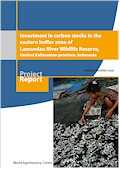| Report |
 |
|
| Title | Investment in carbon stocks in the eastern buffer zone of Lamandau River Wildlife Reserve, Central Kalimantan province, Indonesia: a REDD+ feasibility study | | Author | Laxman Joshi, Janudianto, Meine van Noordwijk and Ujjwal Pradhan | | Year | 2010 | | Institution | World Agroforestry Centre - ICRAF, SEA Regional Office | | City | Bogor, Indonesia | | Report Number | Project Report | | Number of Pages | 91 | | Call Number | RP0268-11 |
|
| Abstract: |
Global interest in reducing the net emissions of greenhouse gases from deforestation, landuse and land-cover change in developing countries has lead to the emergence of a REDD+ (reducing emission from deforestation and degradation plus) framework for maintaining and restoring terrestrial carbon stocks in ‘forests’. While the international rules and (financial) incentives at a national scale are still being negotiated, a large number of sub-national and site-specific ‘REDD+ demonstration projects’ have been identified and designed and many more are in the making under the REDD+ umbrella. REDD+ demonstration projects are not only about reducing carbon emission, but should also effectively and efficiently address the land use–livelihood nexus while exploring alternative development pathways, with implications for both carbon emission and local livelihoods. A key risk in designing REDD+ demonstration projects with a narrow focus on climate change is that this may continue to reward poor governance and do little to alleviate poverty.
The Lamandau River Wildlife Reserve (LRWR or ‘the reserve’) forest conservation and community development project is one of a portfolio of four REDD+ projects being supported by the Clinton Climate Initiative–Forestry program, “Addressing the challenges of scaling pp REDD+ activities in Indonesia”. The program is demonstrating how REDD+ projects can contribute to 1) helping forest dependent communities move out of poverty, 2) conserving tropical forests and degraded peat lands, and 3) ensuring real reductions in GHG emissions associated with land use, land cover changes and deforestation. The program is aligned with governments at national and sub national levels and will contribute to the development of national REDD+ policies, strategies and regulations by addressing the key technical and financial barriers of entry which currently limit the supply of good quality and independently validated REDD+ demonstration projects. The program is building capacities at national and sub national levels of government, non governmental organisations, private sector and communities to implement REDD+ projects by improving national REDD screening processes, learning by doing using a generic five stage (due diligence, feasibility, carbon development, validation and marketing) and ten step carbon development process, establishing links between project based, sub national and national forest carbon accounting systems, exploring options for benefit sharing mechanisms and communicating lessons learned.
The World Agroforestry Centre (ICRAF), in collaboration with Rare Conservation, the Clinton Climate Initiative–Forestry, Yayasan Orangutan Indonesia (Yayorin) and Oranguan Foundation (UK), conducted a feasibility study assessing the potential for enhancing carbon stock in the eastern buffer zone (23 600 ha) of Lamandau River Wildlife Reserve (LRWR), Central Kalimantan province. Beyond the current carbon stock and a projected baseline of ‘business as usual’, assessment of current rights and livelihood strategies in the area is needed for study of ‘additionality’ (carbon stock increases above baseline attributable to project interventions), ‘leakage’ (negative impacts on carbon stocks outside the project area attributable to project interventions) and ‘permanence’ (or leakage in time). We used the RESFA (REDD/REALU Site-level Feasibility Appraisal1 as the framework for studying the key livelihoods, land-use change, carbon stock and tenure issues to develop prospective scenarios and impact predictions.
Overall feasibility was assessed through answers to five questions.
A) Who are the land users, what do they do and what alternative options exist for them?
B) Who has claims of ownership and legality of current land use, who not?
C) How much carbon is currently stored in the landscape, linked to land-use practices?
D) Where do the various land-use practices take place and how much are they
changing?
E) What can be done to reduce threats to carbon stocks and enhance carbon storage?
How can leakage be prevented, additionality be claimed and permanence made
likely? |
|